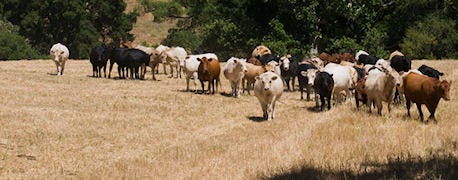July 23, 2012

A new USDA Economic Research Service report released Friday examined the expected impacts of the 2012 drought on farms and food, estimating that retail prices for meats and dairy will begin to climb as a result of the drought within two months.
The report, which highlighted impacts for consumers, farms, and the crop and livestock sectors, said that though changes are already starting to emerge, full impact will not be measurable for 10-12 months.
Food Prices

New USDA Economic Research Service drought report foreshadows upcoming drought impacts.
Using Consumer Price Indices, the ERS estimates that as a commodity price increases, about 14-15% of that increase is passed on to the retail price of products that use that commodity as an ingredient. Further, drought conditions and therefore higher grain prices may lead to herd culling and ultimately a decrease in meat supply. Over time, shrinking supplies could drive prices higher.
Farms
Because almost 40% of productive land and 62% of farms are experiencing some sort of drought, the ERS estimates that the 2012 drought is more extensive than any drought since the 1950s.
ERS data compiled the distribution of drought severity by livestock type and crop type, indicating that as drought increases, value of livestock and value of crop production decreases steadily.
Crops
Early July forecasts for the corn crop estimated yield to be the third largest, but with deteriorating crop conditions the ERS is expecting historically low corn stocks and tight supplies to begin the new marketing year.
A 20-bushel decline in corn yield in early July lowered expectations for record yields, which was further insulted by continued deterioration. The USDA will again estimate yields on August 10, though promising figures aren't expected. Numbers presented by USDA are a far cry from the initial yields and quality expected from an encouraging early planting season.
Drought conditions will also affect the soybean outlook, as the planting season has shifted critical development periods from August into early July.
Soybeans are also tight going into the 2012 harvest, and prices could rise sharply if drought conditions persist.
Wheat and cotton are relatively comfortable, with much of the wheat harvest completed prior to heavy drought conditions and 44% of the cotton rated as good or excellent.

PHOTO: USDA ERS
Livestock
Feed and hay availability and cost is affecting livestock producers. ERS estimates that 66% of hay areas are affected by drought, causing higher production costs for beef, hog and poultry operations.
Dairy outputs are expected to be lower as well, but farmers should see higher milk prices for 2013, though below prices in 2011.

PHOTO: USDA ERS
View the full report here.
Keep up on the drought
Farm Progress is pooling all the coverage of the drought from across the country into a single place—DatelineDrought.com—where you can see a daily video from Max Armstrong, Farm Progress director of broadcast, and Farm Futures Senior Editor Bryce Knorr, along with national, local and regional coverage of the ongoing drought across the heart of the country.
You May Also Like




